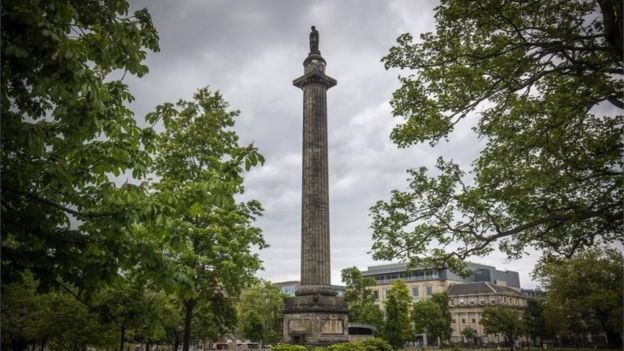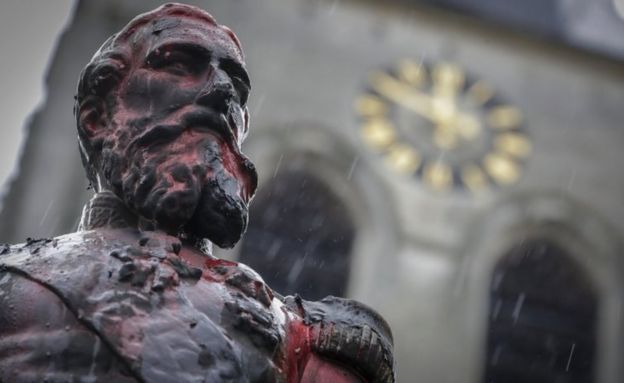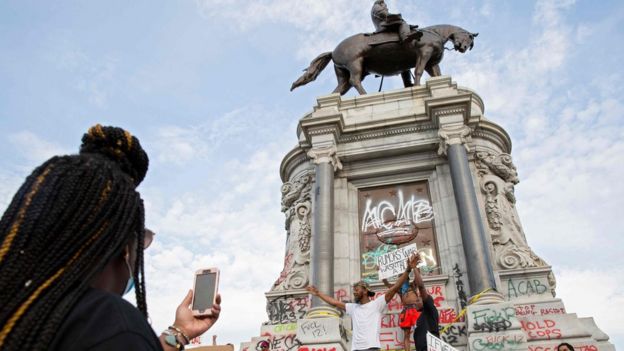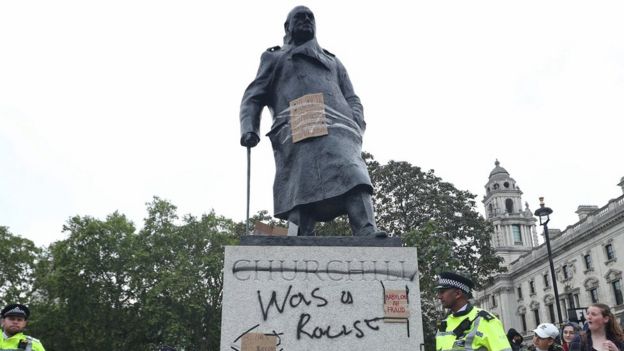When anti-racism protesters in England pulled down the statue of a 17th Century slave trader and promptly dumped it in the deep waters of a harbour, the message was clear.
Edward Colston's ships are believed to have transported about 80,000 men, women and children from Africa to the Americas. But his memory has been honoured for centuries in his home city of Bristol, which benefited from his vast wealth.
While the government condemned the act on Sunday, protesters said they hoped it signified change.
"Statues are about saying: 'This was a great man who did great things.' That is not true, he was a slave trader and a murderer," historian David Olusoga told BBC News.
Global protests, like the one in Bristol, have shed a light on cities' colonial or slave-owning history - and the figures that represent it.
Henry Dundas

A monument in the Scottish capital Edinburgh commemorating a politician who delayed the abolition of slavery has been spray-painted with the words "George Floyd" and "BLM" (for Black Lives Matters).
The 150ft (46m) tall Melville Monument, in Edinburgh's St Andrew Square, was erected in 1823 in memory of Henry Dundas.
Dundas was one of the country's most influential politicians in the 18th and 19th centuries and had the nickname "the uncrowned king".
He put forward an amendment to a bill which would have abolished slavery in 1792, opting for a more "gradual" approach.
This allowed the practice to continue for 15 years longer than it otherwise would have done.

Thousands of people have signed petitions calling for the monument to be taken down.
Amid protests over the monument, officials have announced that a plaque will be added to it offering "reflective" details about the city's links to slavery.
"We need to tell our story and make sure people understand Edinburgh's role in the world historically - not just the bits that we're proud of but frankly the bits we're ashamed of as well," Edinburgh City Council leader Adam McVey told BBC Scotland.
King Leopold II

People in Belgium are calling for statues of the country's longest-reigning king, Leopold II, to be dismantled.
Online petitions demanding their removal have garnered tens of thousands of signatures, while some anti-racism protesters have taken more direct action.
A bust of the colonial-era king in the city of Ghent was covered in red paint, with cloth over its head marked with the words "I can't breathe". The cloth evoked those last spoken by George Floyd as a white police officer knelt on his neck, leading to the recent protests.
In Antwerp, another statue of the king was set on fire by protesters and later removed by officials, who said it had been transferred to a museum. In the capital Brussels, a statue was marked with the word "assassin".
King Leopold II ruled Belgium from 1865 to 1909, but he is best remembered for his terrible legacy in the Democratic Republic of the Congo.
Between 1885 and 1908, the monarch of one of Europe's smallest countries made the DRC, then known as the Congo Free State, his own private colony.
He turned it into a massive labour camp, making a fortune from the rubber trade. Those who resisted slave labour were often shot, and Leopold's troops were ordered to collect the hands of their victims.
Leopold reigned over the mass deaths of an estimated 10 million Congolese. He also put Congolese people into a human zoo in Belgium.
He was forced to relinquish his control of the Congo Free State in 1908, but the country did not gain independence from Belgium until 1960.
Some who are against the statues' removal say Belgium's wealth is because of its success as a trading economy under King Leopold II.
Robert E Lee

The US state of Virginia is removing a statue of Confederate General Robert E Lee, which has been vandalised in the George Floyd protests.
Announcing the decision to remove the 12-ton monument erected in 1890, Governor Ralph Northam said: "We no longer preach a false version of history.
"That statue has been there a long time. But it was wrong then, and it's wrong now. So we're taking it down."
It is among five Confederate statues on Monument Avenue, in the state capital Richmond, that have been marked with graffiti during the protests, including messages to "stop white supremacy".
Robert E Lee was a commander of the pro-slavery Confederate States Army, a coalition of southern states, in the US Civil War of 1861 to 1865.
Lee also married into one of the wealthiest slave-holding families in Virginia and took leave from the army to run the family estate following his father-in-law's death. He met resistance from slaves who expected to be freed.
Documents show that he encouraged severe beatings for those who tried to escape. He is also said to have broken up slave families.
Many in the US view Lee as a symbol of the country's history of slavery and racial oppression.
Other Confederacy statues have also been defaced by protesters.
Some of those who believe the statues of Confederate figures should remain standing argue that they are markers of US history and southern culture.
Winston Churchill

A statue in London of former British Prime Minister Winston Churchill was vandalised with graffiti declaring him a "racist".
Churchill is lauded for leading Britain to victory in World War Two.
He is described on the UK government website as "an inspirational statesman, writer, orator and leader", and was voted the greatest ever Briton in a 2002 BBC poll.
But for some he remains a deeply controversial figure, in part because of his views on race.
"It's absolutely not in doubt that Churchill was racist," said historian Richard Toye, co-author of the upcoming book The Churchill Myths. "He certainly regarded white people as being superior, he said that explicitly.
"He made unpleasant remarks about Indians who he said were a beastly people with a beastly religion, and he said unpleasant things about Chinese people. I could go on.
"One obviously needs to acknowledge that Churchill's Victorian background was certainly an influence on him, but I would say it wasn't necessarily a defining or determining influence on his racial views because they did oscillate through time," he added.
In a 2015 interview with the BBC, John Charmley, author of Churchill: The End of Glory, said the late prime minister believed in racial hierarchies, in which white protestant Christians were at the top, above white Catholics, while Indians were higher than Africans.
In 1937, Churchill told the Palestine Royal Commission: "I do not admit for instance, that a great wrong has been done to the Red Indians of America or the black people of Australia. I do not admit that a wrong has been done to these people by the fact that a stronger race, a higher-grade race, a more worldly-wise race, to put it that way, has come in and taken their place."
Churchill has also faced criticism over his remarks on Jews and Islam, and his actions, or lack thereof, in the 1943 Bengal famine, which killed more than two million people.
Churchill's grandson, Sir Nicholas Soames, has previously said his grandfather was "a child of the Edwardian age and spoke the language of [it]."
Latest Stories
-
Baltasar Coin becomes first Ghanaian meme coin to hit DEX Screener at $100K market cap
3 minutes -
EC blames re-collation of disputed results on widespread lawlessness by party supporters
17 minutes -
Top 20 Ghanaian songs released in 2024
38 minutes -
Beating Messi’s Inter Miami to MLS Cup feels amazing – Joseph Paintsil
52 minutes -
NDC administration will reverse all ‘last-minute’ gov’t employee promotions – Asiedu Nketiah
1 hour -
Kudus sights ‘authority and kingship’ for elephant stool celebration
1 hour -
We’ll embrace cutting-edge technologies to address emerging healthcare needs – Prof. Antwi-Kusi
2 hours -
Nana Aba Anamoah, Cwesi Oteng special guests for Philip Nai and Friends’ charity event
2 hours -
Environmental protection officers receive training on how to tackle climate change
2 hours -
CLOGSAG vows to resist partisan appointments in Civil, Local Government Service
3 hours -
Peasant Farmers Association welcomes Mahama’s move to rename Agric Ministry
3 hours -
NDC grateful to chiefs, people of Bono Region -Asiedu Nketia
3 hours -
Ban on smoking in public: FDA engages food service establishments on compliance
3 hours -
Mahama’s administration to consider opening Ghana’s Mission in Budapest
3 hours -
GEPA commits to building robust systems that empower MSMEs
3 hours
